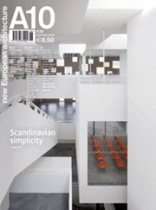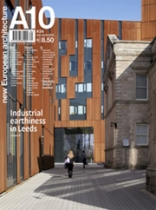
A10
#35 Sep/Oct 2010
| Nakladatelství: | Boom publishers |
| Rok vydání: | 2010 |
| ISSN: | 1573-3815 |
| Formát: | 24,5 x 33 cm, 70 stran, brožovaná |
| Jazyk: | anglicky |
| Web: | http://www.a10.eu |
| Běžná cena: | 240 Kč |
| Naše cena: | 200 Kč (bez 0 % DPH: 200,00 Kč) |
| 8,4 € (bez 0 % DPH: 8,40 €) | |
| Skladem: | 1 ks (standardní doba expedice do 5 dnů) |
On the spot
News and observations
- BIG's 8 House in Ørestad, Copenhagen (DK)
- Carmody Groarke's pop-up restaurant, London (UK)
- Update: new architecture around Lake Balaton (HU)
- The comeback of the Latvian country home
- Fab Lab Solar House
and more…
Start
New projects
- Technical college, Roskilde (DK) by Christiansen & Co. Architects
- Library and centre for new media, Ghent (BE) by RCR Arquitectes and Coussée & Goris architecten
- Cultural centre, Ostrava (CZ) by Maxwan
- Townhouses, Helsinki (FI) by Heikki Muntola
Interview
Dietmar Feichtinger: From A to B
The Simone de Beauvoir Bridge in Paris is a prestige project. But nowadays Dietmar Feichtinger is keen to direct media attention away from it and onto his other work. Yet in conversation he nonetheless starts talking about that very work. When all's said and done, it sums up the structural and site-responsive approach inherent to his architecture, whether it be a bridge or a buılding.
Ready
New buildings
- Library, Barcelona (ES) by Rafael Perera Leoz
- Music and art house, Istanbul (TR) by GAD Architecture
- Office building, St. Ingbert (DE) by Kergaßner Architects
- Retail park, Assago (IT) by 5+1AA
- Museum, Winden am See (AT) by gaupenraub +/-
- Swimming pool, Buckinghamshire (UK) by Paul+O Architects
- Sports park, Ljubljana (SI) by Sadar Vuga Arhitekti
- House, Warsaw (PL) by Piotr Brzoza and Marcin Kwietowicz
- Training and conference centre, Oslo (NO) by Element Arkitekter
- Museum, Louvres (FR) by Bruno Pantz
- Museum, Luxembourg (LU) by Philippe Schmit architects
Section
Brick's back
Brick and ceramic are among the oldest materials in architecture, along with stone, wood and clay. The oldest bricks ever found – in the Middle East, where Iraq lies today – are as much as 10,000 years old. As such, brick stands for tradition in architecture. A long tradition of big and imposing buildings – the ancient stupas in Asia, the magnificent tiled city walls of Babylon (the Ishtar Gate, on display in the Pergamon Museum in Berlin), churches in Europe – as well as perfectly ordinary houses. That antithesis is typical of brick – on its own it is nothing special, but applied on a large scale, brick is an exceptionally impressive and rich material. As Mies van der Rohe said: 'Architecture starts when you carefully put two bricks together. There it begins.'
Eurovision
Focusing on European countries, cities and regions
- Socialist shopping cathedrals in the former Yugoslavia
- A seven-day architectural tour of Portugal
- Home: Fritz Barth's eclectic dream house, Fellbach (DE)
Out of obscurity
Buildings from the margins of modern history
Daniel Golling goes back to Klas Fåhræus's crematorium and cemetery (1957–1964) in the Stockholm suburb of Råcksta where, together with landscape architect Gunnar Martinsson, Fåhræus designed an environment of elegant simplicity.
News and observations
- BIG's 8 House in Ørestad, Copenhagen (DK)
- Carmody Groarke's pop-up restaurant, London (UK)
- Update: new architecture around Lake Balaton (HU)
- The comeback of the Latvian country home
- Fab Lab Solar House
and more…
Start
New projects
- Technical college, Roskilde (DK) by Christiansen & Co. Architects
- Library and centre for new media, Ghent (BE) by RCR Arquitectes and Coussée & Goris architecten
- Cultural centre, Ostrava (CZ) by Maxwan
- Townhouses, Helsinki (FI) by Heikki Muntola
Interview
Dietmar Feichtinger: From A to B
The Simone de Beauvoir Bridge in Paris is a prestige project. But nowadays Dietmar Feichtinger is keen to direct media attention away from it and onto his other work. Yet in conversation he nonetheless starts talking about that very work. When all's said and done, it sums up the structural and site-responsive approach inherent to his architecture, whether it be a bridge or a buılding.
Ready
New buildings
- Library, Barcelona (ES) by Rafael Perera Leoz
- Music and art house, Istanbul (TR) by GAD Architecture
- Office building, St. Ingbert (DE) by Kergaßner Architects
- Retail park, Assago (IT) by 5+1AA
- Museum, Winden am See (AT) by gaupenraub +/-
- Swimming pool, Buckinghamshire (UK) by Paul+O Architects
- Sports park, Ljubljana (SI) by Sadar Vuga Arhitekti
- House, Warsaw (PL) by Piotr Brzoza and Marcin Kwietowicz
- Training and conference centre, Oslo (NO) by Element Arkitekter
- Museum, Louvres (FR) by Bruno Pantz
- Museum, Luxembourg (LU) by Philippe Schmit architects
Section
Brick's back
Brick and ceramic are among the oldest materials in architecture, along with stone, wood and clay. The oldest bricks ever found – in the Middle East, where Iraq lies today – are as much as 10,000 years old. As such, brick stands for tradition in architecture. A long tradition of big and imposing buildings – the ancient stupas in Asia, the magnificent tiled city walls of Babylon (the Ishtar Gate, on display in the Pergamon Museum in Berlin), churches in Europe – as well as perfectly ordinary houses. That antithesis is typical of brick – on its own it is nothing special, but applied on a large scale, brick is an exceptionally impressive and rich material. As Mies van der Rohe said: 'Architecture starts when you carefully put two bricks together. There it begins.'
Eurovision
Focusing on European countries, cities and regions
- Socialist shopping cathedrals in the former Yugoslavia
- A seven-day architectural tour of Portugal
- Home: Fritz Barth's eclectic dream house, Fellbach (DE)
Out of obscurity
Buildings from the margins of modern history
Daniel Golling goes back to Klas Fåhræus's crematorium and cemetery (1957–1964) in the Stockholm suburb of Råcksta where, together with landscape architect Gunnar Martinsson, Fåhræus designed an environment of elegant simplicity.
Související
|
|
|
0 komentářů
přidat komentář














